Here it is finally. After seeing the presentation of the new generation of MacBook Air, MacBook Pro 13 ″ and Mac Mini, they were looking forward to getting their hands on one of the new Mac models and the Mini in particular. The writer has had all generations of Mac Mini, from the very old PowerPC versions, then through the various generations with Intel CPUs, including the model presented in 2018 (here our review), the latter a “faithful” companion and only apparently “Mini”, configurable in various ways and able to perfectly perform the most disparate tasks. Having had all the Mini models available so far, we were looking forward to being able to try out the latest addition as well. Features, peculiarities, impressions and curiosities are listed below.
Packaging
The Mac Mini 2020 arrives inside a cardboard box no different from the previous one. Inside there is only the actual computer and the power cable (Italian / Euro plug). The Mini, as you probably know, is perfect for those who already have a monitor, keyboard and mouse: just attach these accessories and the computer is ready. You can take advantage of any USB-C, Thunderbolt, HDMI or other monitor using adapters (which must be purchased separately). Keyboard and mouse are not included; you can buy accessories or any Bluetooth or USB mouse and keyboard.
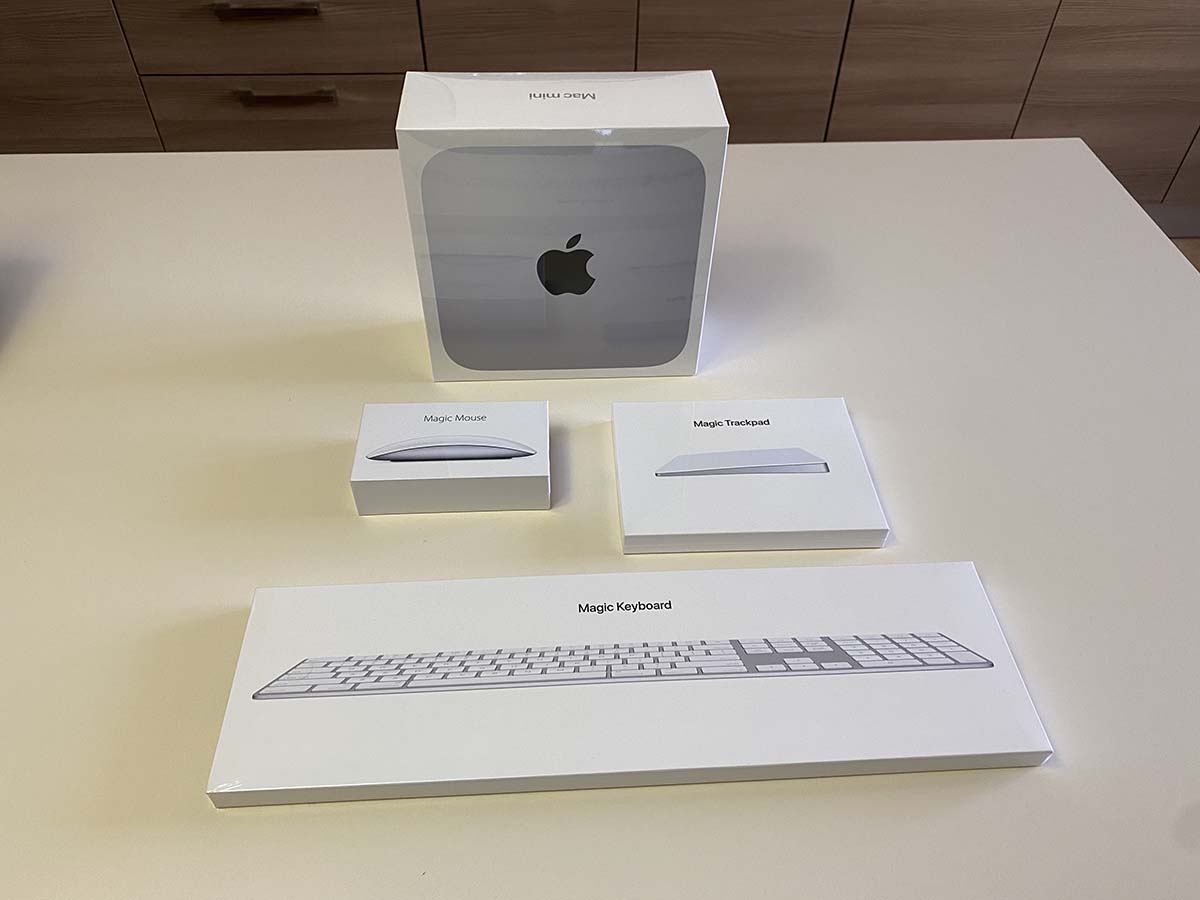 The Mac Mini 2020 arrives in a box very similar to that of the previous model. Mouse and keyboard are NOT included: any USB / Bluetooth mouse and USB / Bluetooth keyboard can be used. In the picture the new Mini together with the Magic Mouse, the extended Magic Keyboard and the Magic Trackpad.
The Mac Mini 2020 arrives in a box very similar to that of the previous model. Mouse and keyboard are NOT included: any USB / Bluetooth mouse and USB / Bluetooth keyboard can be used. In the picture the new Mini together with the Magic Mouse, the extended Magic Keyboard and the Magic Trackpad.
Dimensions, ports, connections
Taken out of the box, the Mini measures 3.6cm (height) x 19.7cm (width) x 19.7cm (depth). The weight is 1.2kg. On the back we find the power connector, the Gigabit Ethernet port, two Thunderbolt / USB 4 ports, the HDMI 2.0 port, two USB ‑ A ports (up to 5 Gbps), the 3.5 mm headphone jack.
In addition to Gigabit Ethernet 10/100 / 1000BASE ‑ T, Wi ‑ Fi 6 802.11ax connectivity (compatible with IEEE 802.11a / b / g / n / ac) and Bluetooth 5.0 wireless technology are supported. The speaker is integrated (a tiny speaker that offers the minimum wage) and luckily you can connect headphones or external speakers using the 3.5mm jack.
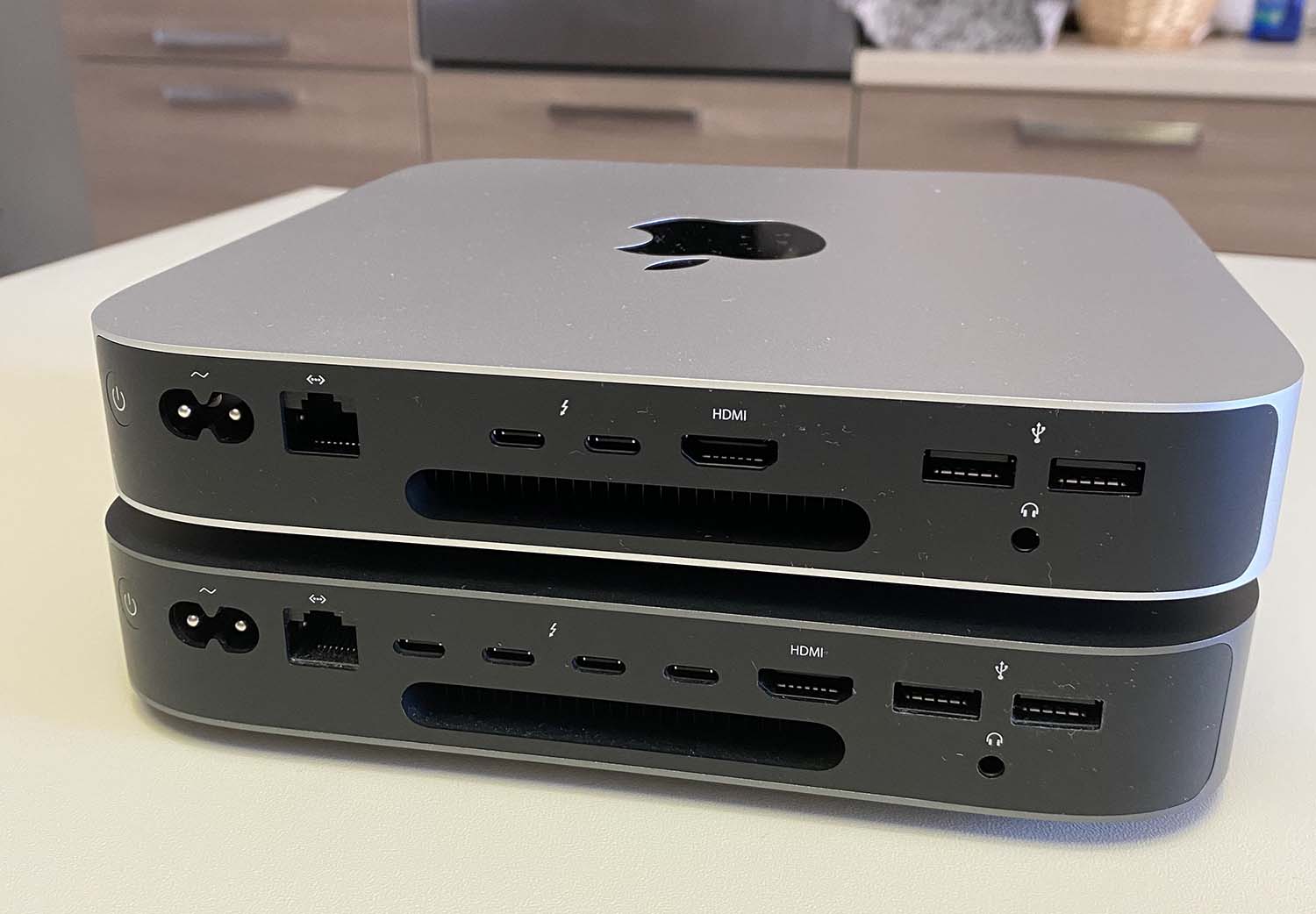 Mac mini 2018 (below) and Mac Mini 2020 (above) in comparison.
Mac mini 2018 (below) and Mac Mini 2020 (above) in comparison.
Two Thunderbolt / USB 4 ports allow you to connect Displayport monitors, support Thunderbolt 3 peripherals (up to 40 Gbps), USB 3.1 Gen 2 (up to 10 Gbps), Thunderbolt 2 peripherals, HDMI, DVI and VGA via adapters (sold separately ).
The Mini supports up to two monitors simultaneously: one monitor with resolution up to 6K @ 60Hz connected via Thunderbolt and one monitor with resolution up to 4K @ 60Hz connected via HDMI 2.0. Native DisplayPort output via USB ‑ C works as Thunderbolt 2, DVI and VGA output (adapters required). The HDMI monitor output supports a monitor with resolution up to 4K at 60Hz; you can take advantage of any DVI outputs with an HDMI to DVI adapter.
The old Mini 2018 was able to support up to three displays (two with resolution up to 4096 × 2304 at 60Hz connected via Thunderbolt and the third via HDMI 2), while the new one stops at two displays but with resolution up to 6K ( at 60Hz).
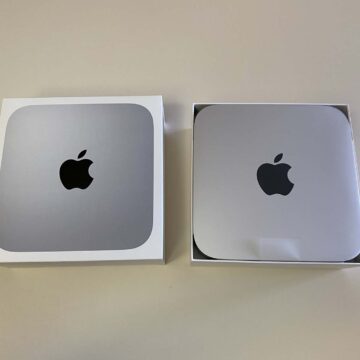
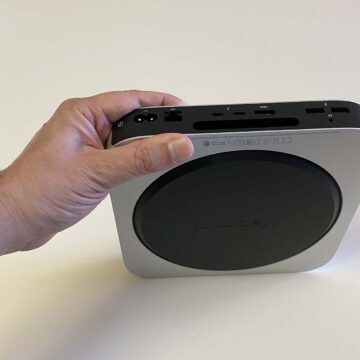
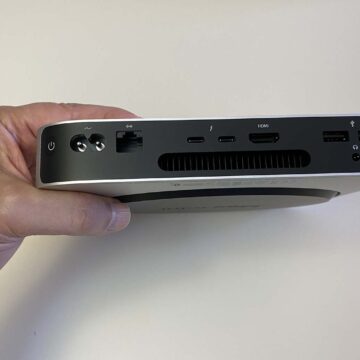
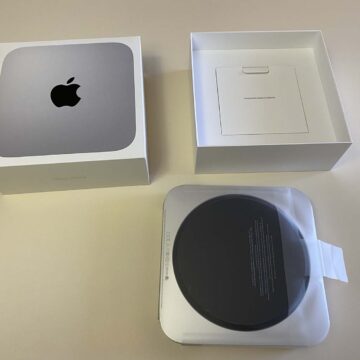
When ordering it is possible to configure the Mini in various ways but the “heart” -chip M1 always remains the same. It starts at € 819.00 for the basic configuration with 8GB of unified memory (a single pool of broadband and low latency memory that allows apps to share data between the CPU, GPU and Neural Engine with the maximum efficiency) and the only possible variation for the RAM memory is the choice of 16GB. The memory of Mac mini 2020 is not accessible by the user: if you think that more may be needed in the future, you must ask for the expansion at the time of purchase.
The storage offered as a base is a 256GB SSD but you can choose up to 2TB of storage (256GB SSD, or 512GB, or 1TB or 2TB).
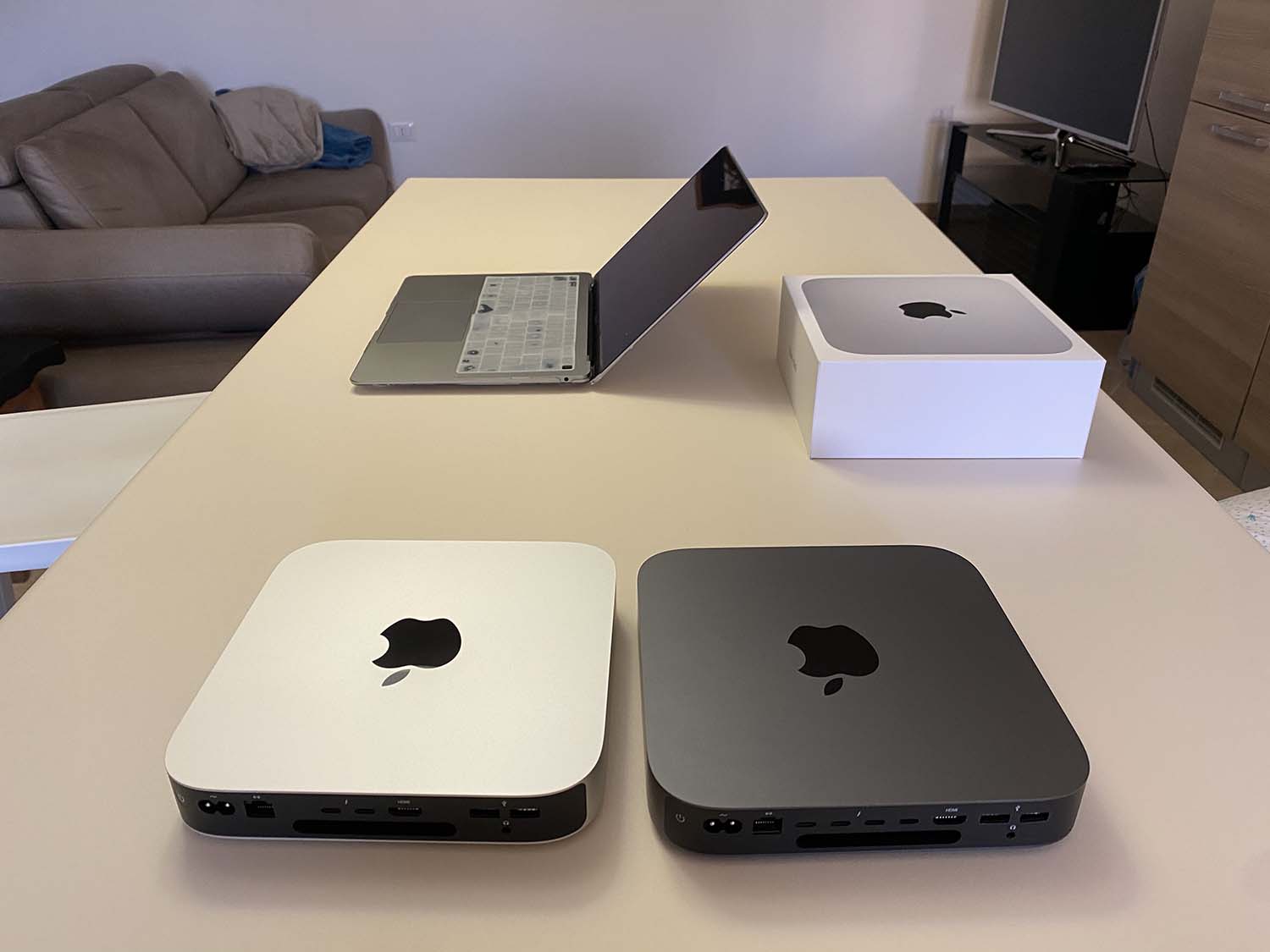 Old and new Mac mini and, in the background, the MacBook Air.
Old and new Mac mini and, in the background, the MacBook Air.
First start up
At the first start we combined a keyboard and a mouse, chose the system language and the other customary settings (iCloud, Filevault, WiFI password, etc.). The Mini obviously comes with the new macOS Big Sur as standard, an operating system indistinguishable from that for machines with Intel CPUs. What is immediately striking is the impressive speed with which it is possible to launch any standard application, thanks to the new architecture and also the new series SSD drives.
Try with non-optimized applications
Applications compiled to work natively with the M1 chip are lightning-fast and start instantly. Various software houses have already released or are about to release optimized or “universal” applications, capable of running both on Macs with M1 CPUs and on Macs with Intel CPUs. Applications for Macs with Intel CPUs that have not yet been optimized or made universal can still be run thanks to a technology integrated into the operating system called “Rosetta 2”. All applications are supported, with the exception of particular software that exploit intrinsic visualization technologies of Intel processors.
The first launch of non-optimized apps is slower but from the second launch onwards there is no longer any slowness (this is normal since Rosetta 2 has to “translate” the Intel instructions. The first non-optimized software we installed was Office 2019 for Mac When installing the Microsoft package the operating system asked if we wanted to install Rosetta; after a few seconds Rosetta has been activated (it is nothing visible: it is a “transparent” technology that runs in the background, called up if necessary) allowing the package to be installed transparently, taking a little longer than the time normally taken to complete this type of installation (due to the need to translate various utilities run by the installer with Rosetta).
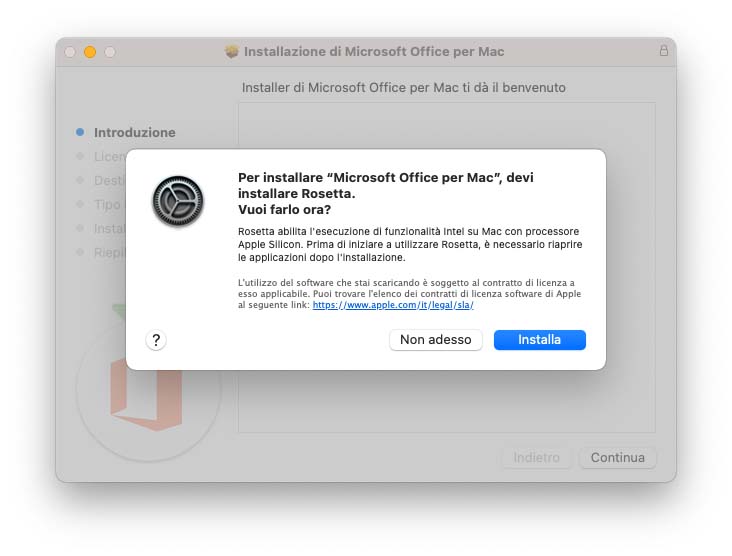 Example of message that appears at the first start of software created for Mac with Intel CPU
Example of message that appears at the first start of software created for Mac with Intel CPU
The first non-optimized software we tried to launch after installing Office 2019 was Word . The first run took about 20 seconds; at the second start it started in about 4 seconds . Once the application is started, there are no differences in speed compared to what we were used to on the machine with Intel CPU, even when loading documents with hundreds of pages, complex documents with various images and links. Same with PowerPoint and Excel: slower first start; from the second start on, faster start and use without any problems. The same goes for applications of various types: we tried to run Illustrator, Photoshop, InDesign and dozens and dozens of other software not yet optimized but all fully functional on the new Mac with M1 CPU. The software works very well, without batting an eye, in some cases even giving the impression of responding faster.
Optimized applications
The speed is noticeable (and how!) With optimized applications. Apple already has its own ready: those of the iWork suite, iMovie, Garageband but also Final Cut Pro X and Logic Pro. Working with Final Cut Pro is a pleasure and the Mini does not bat an eyelid to manage movies even in 4K 60 fps HDR Dolby Vision , allowing you to edit and render with speeds that perhaps only those who use a latest generation Mac Pro are accustomed to. The fluidity is impressive and dwarfs even a 5K iMac with Intel i5 with 2GB external video card and 32GB of RAM . With video editing you can work with extreme fluidity: the Mini seems to “digest” 4K 60fps files, as if nothing had happened.
Single-core, multi-core and application benchmarks
Cinebench
We tested various benchmarking tools on the new Mini. The first one we started is Cinebench R23 , a reference tool that allows you to take into account real uses in the 'field of software for 3D modeling, animation, and rendering. The score obtained in the multi-core tests is 7786, higher than what can be obtained on a computer with Intel Xeon X5650 and slightly lower than what can be obtained with an Intel Xexon E5-2697 v2; in single-core tests the score is 1520, higher than the Intel Core i7-1165G7 # 15W and similar to the Intel Core i7-1165G7 @ 28W.
The performance compared to the Mac Mini i3 3.6Ghz quad-core is practically equal to double, making the previous processor used on the base model of mini pale. Using the old version of Cinebench, not optimized for CPU M1 (compiled only for Intel processors) we got a score of 2108 in the multi-core tests and 408 in the single-core tests, once again superior performance to the Mac Mini with Intel CPU at 3.6Ghz with 44% faster speed in multi-core tests and 8% in single-core tests.
Geekbench
We performed the second test with Geekbench , the Primate Labs cross-platform benchmark that allows you to evaluate performance of the CPUs providing two results: one for workloads running on a single core and the other for those running using all available computing cores. The Geekbench score was 1723 in single-core tests, and 7561 in multi-score tests. As a comparison with the Mac mini 2018 – in the 3.6Ghz quad-core i3 variant we obtained a score of 960 in the single-core tests and 3353 in the multi-core tests. In practice, the Mac Mini with the SOC M1 offers performance, once again equal to double.
Aja System Test for SSD
The speed of the SSD is excellent. We had the first confirmation with Aja System Test, utility that allows you to check the transfer values internal SSD data in sequential mode. The results are more than excellent: 2121 MB / sec in writing and 2870 in reading. For comparison, with the 2018 Mac Mini we got: 2,866 MB / sec write and 3,043 MB / sec read. The Mac Mini 2020 is fast in opening the apps and in the various tasks required: opening and closing windows, returning from sleep (instantaneous) and also in software such as Safari and Chrome you can see the difference in the scrolling of the pages.
iMovie Export
Exporting from iMovie of a movie of about 30 minutes with various transitions and titles took 2 minutes and 9 seconds on the Mac with M1 versus almost 5 minutes on the old Mini with Intel. Also in Garageband you can see the difference: the export of an audio file of 42 minutes in MP3 format 256k took 10% less time than the same test performed on the 2018 Mini base with Intel CPU.
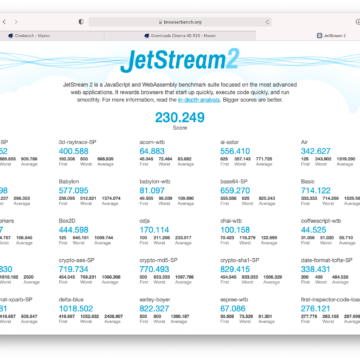 JetStream 2 is a tested bencharm capable of putting modern web browsers under pressure.
JetStream 2 is a tested bencharm capable of putting modern web browsers under pressure. 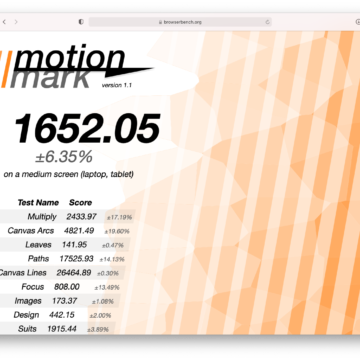 MotioMark measures the browser's ability to load graphics even on the move.
MotioMark measures the browser's ability to load graphics even on the move. 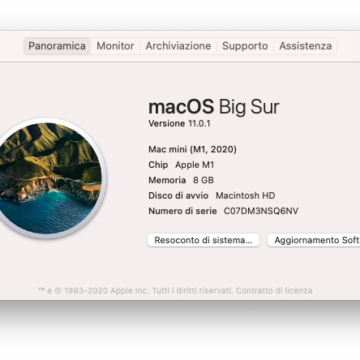 The “About This Mac” window
The “About This Mac” window 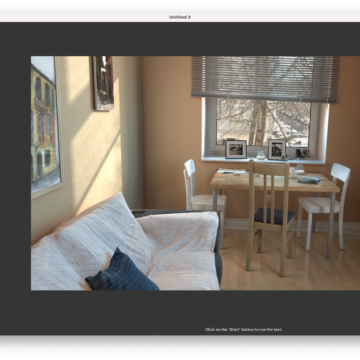 Single-core test with Cinebench R23
Single-core test with Cinebench R23 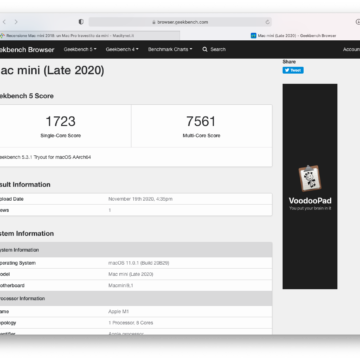 Geekbench
Geekbench 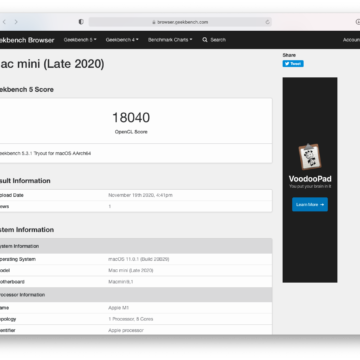 Geekbench
Geekbench 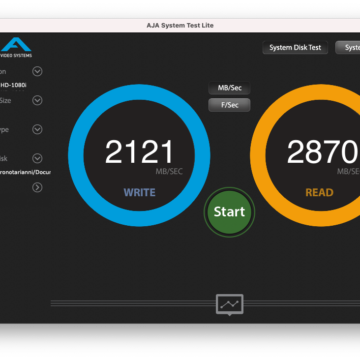
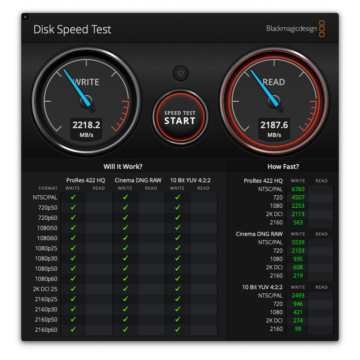
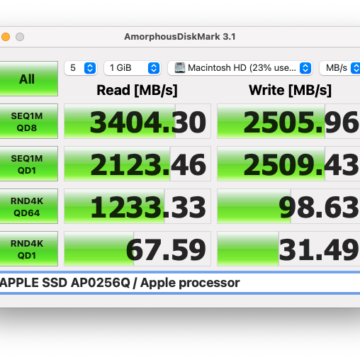
![]() With macOS Big Sur on new Macs it is easy to know the type of app installed on Mac. Just click on the application icon, choose “Get Info” from the “File” menu ”Of the Finder: a window appears with various details; to the right of the “Type” indication, the type of application appears with, possibly the indication “Universal”, a sign that the application in question can be run natively both on Macs with Intel CPUs and on those with CPUs M1 from Apple.
With macOS Big Sur on new Macs it is easy to know the type of app installed on Mac. Just click on the application icon, choose “Get Info” from the “File” menu ”Of the Finder: a window appears with various details; to the right of the “Type” indication, the type of application appears with, possibly the indication “Universal”, a sign that the application in question can be run natively both on Macs with Intel CPUs and on those with CPUs M1 from Apple.
Graphic performance
One of the things that has so far made Mac Mini users turn up their noses was the absence of a decent video card. With the M1 Apple promises “the fastest integrated graphics ever seen in a personal computer”; the SoC, in fact, includes an evolved GPU. Apple explains that it benefits from years of analyzing Mac applications, including commonly used apps and the most demanding professional workloads.
The GPU of the M1 chip is a generational leap in terms of integrated graphics. With eight cores capable of running nearly 25,000 threads simultaneously, the GPU can handle extremely demanding tasks with ease, from smooth playback of multiple 4K video streams to rendering complex 3D scenes. It boasts a throughput of 2.6 teraflops allowing it to manage even rather complex tasks without problems.
Test with Rise of the Tomb Raider and Civilization VI , two games NOT optimized for M1 (currently only available in native version for Mac with Intel CPU) highlighting performance once again superior to what is possible get on the previous base Mac mini: up to 73 fps (at 1280 × 720 pixels) versus the awkward 11 fps of the old mini, despite – we repeat – the mini with M1 emulating Intel code. By running tests involving OpenCL or Metal graphics frameworks, the Mini with the M1 is able to dwarf its predecessor and even Intel computers with – on paper – more powerful processors.
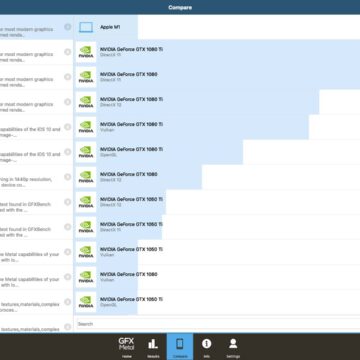 Benchmark with GFX Metal
Benchmark with GFX Metal  Benchmark with GFX Metal
Benchmark with GFX Metal
Other significant features
The M1 chip packs features such as an ISP processor for managing video-related features, the latest Secure Enclave for security, a high-performance storage controller with AES encryption hardware, low-power encoding and decoding engines, and High efficiency for excellent performance, an Apple-designed Thunderbolt controller with support for USB 4, transfer speeds of up to 40Gbps and compatibility with more peripherals than ever.
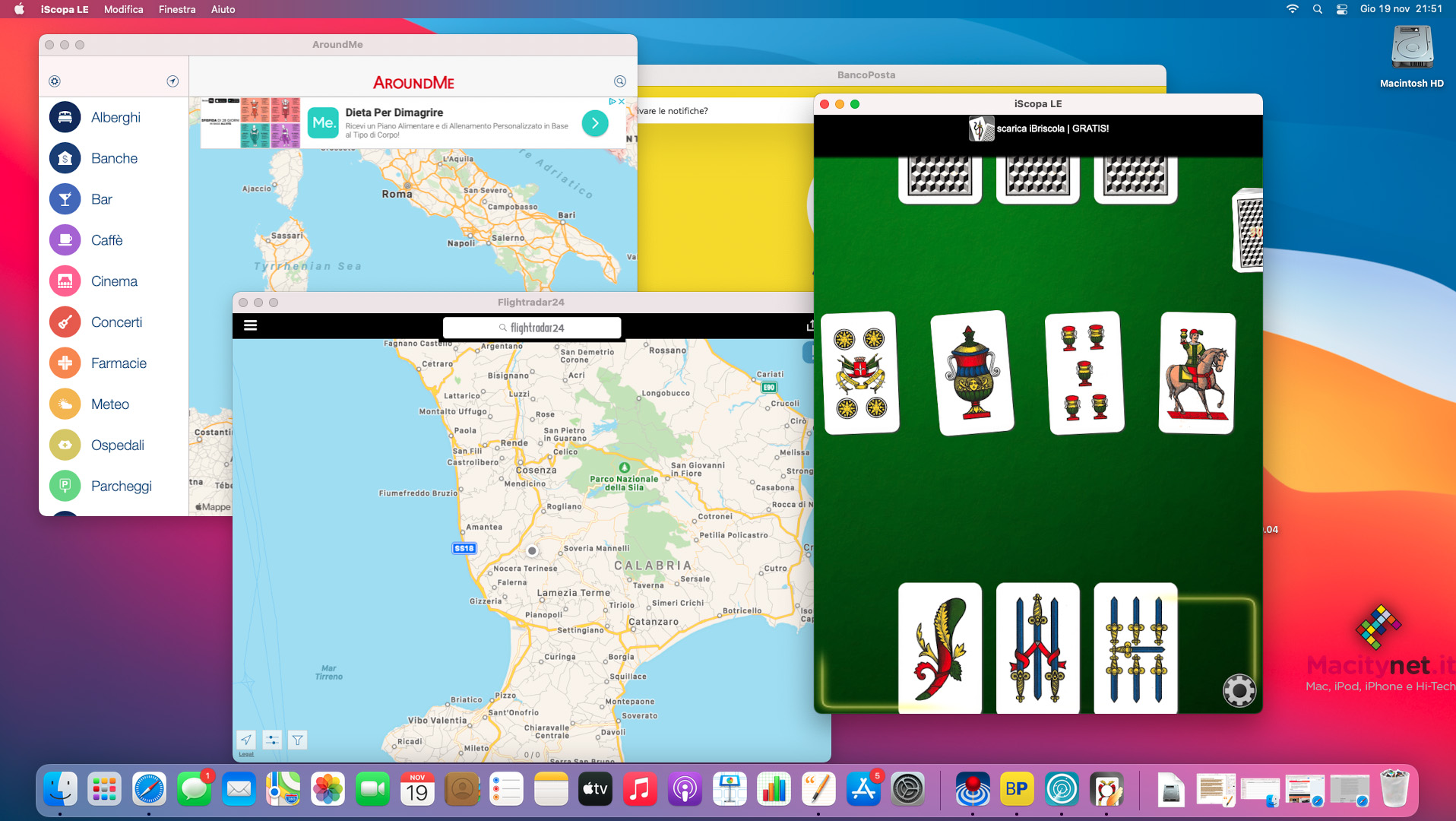 Some iPhone apps launched on a Mac with Apple's M1 CPU.
Some iPhone apps launched on a Mac with Apple's M1 CPU.
Conclusions
The machine can be opened but in practice it makes no sense: there is no component that can be updated or changed. The Mac Mini is Apple's most affordable Mac anyway. It has always been an all-rounder machine and with the latest update it is even more so. Previously we would never have recommended a Mini to anyone who works with video applications or other “demanding” software, but now M1 also makes the Mini suitable for these tasks. The previous model is blown away on all fronts.
The only downsides are: the presence of only two Thunderbolt / USB-4 ports (you may need to buy a hub), “limitations” in the maximum number of displays that can be connected (2 instead of 3) and little else (the speaker that offers the minimum trade union). For everything else it is a very fast, silent, versatile machine with “muscles” that allow it to be placed in places where it made no sense before and we would never have imagined.
To paraphrase an old Esso advertisement, we could say “there's a tiger in the engine”, a car ready to offer speed and power that you would never have imagined before. The 16GB of RAM (LPDDR4) is the maximum you can have but it doesn't seem like a limit with optimized apps like Final Cut Pro, Logic and more. All the big names are at work and we are sure that we will see some good ones. We will update this page with specific tests related to Photoshop and other software as we get to try them.
The machine starts with a list price of 819.00 euros. We would have liked a lower entry price, even at the cost of giving up something, a “psychological” element that probably would have pushed the sales of the little “tiger” even more.
Pro
Versus
Retail price
The two standard configurations are available in all retail stores and on Amazon. For customized configurations, it is necessary to contact the Apple Store online and in the area or Apple Premium Resellers such as Juice and authorized points of sale with stores throughout Italy.
Right now you can buy the Mac mini on Amazon with this offer: Apple M1 Mac mini chip with 8-core CPU and 8-core GPU 512GB storage – 996 euros (-51 euros)
Here are the possible configurations:
Two basic models.
You can customize your 256 GB Mac mini by adding to the order:
It is possible to customize your 512 GB Mac mini by adding to the order:





